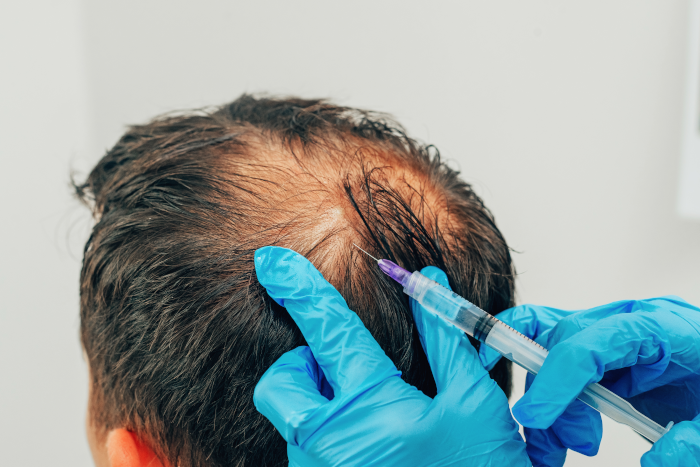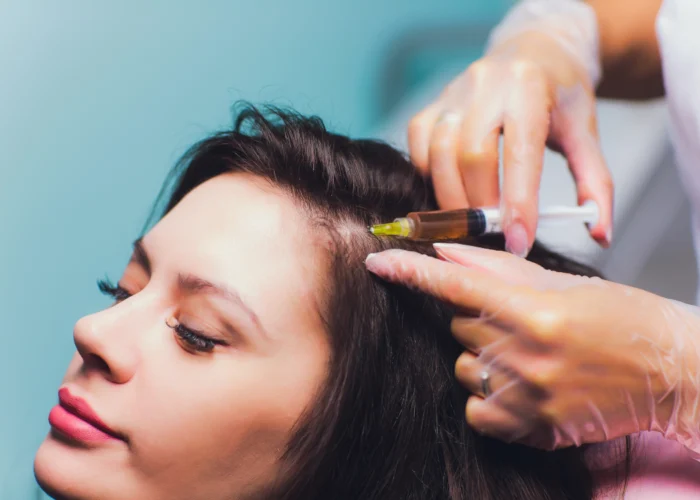PRP Hair Restoration

PRP (Platelet-Rich Plasma) hair restoration is a non-surgical procedure used to promote hair growth and combat hair loss. It involves using a patient’s own blood to extract platelets, which are rich in growth factors. Here’s a description of PRP hair restoration:
Procedure: The PRP hair restoration procedure typically involves the following steps:
Blood Draw: A small amount of blood is drawn from the patient, usually from the arm.
Centrifugation: The drawn blood is placed in a centrifuge machine, which spins it at high speed to separate the platelets from other blood components.
Platelet Separation: After centrifugation, the platelet-rich plasma is extracted, containing a higher concentration of platelets and growth factors.
Scalp Injections: The extracted PRP is then injected into the scalp, specifically targeting areas of hair loss or thinning.
Growth Factors: Platelets contain various growth factors that can stimulate hair growth, including platelet-derived growth factor (PDGF), transforming growth factor (TGF), vascular endothelial growth factor (VEGF), and insulin-like growth factor (IGF). These growth factors help promote the growth of new hair follicles, improve the thickness and quality of existing hair, and increase blood circulation to the scalp.
Hair Restoration Benefits: PRP hair restoration can provide several benefits, including:
Hair Regrowth: The growth factors in PRP can stimulate dormant hair follicles, leading to the growth of new, healthy hair strands.
Hair Thickening: PRP can help improve the thickness and density of existing hair, making it appear fuller and more voluminous.
Hair Quality: PRP may enhance the overall quality of the hair, making it stronger, shinier, and less prone to breakage.
Non-Surgical: PRP hair restoration is a non-surgical procedure, meaning it does not involve incisions, stitches, or significant downtime.
Treatment Sessions: PRP hair restoration typically requires multiple treatment sessions for optimal results. The exact number of sessions can vary depending on the individual’s specific condition and response to treatment. Initially, treatments are often performed once a month, followed by maintenance sessions every few months to sustain the results.
Safety and Side Effects: PRP hair restoration is generally considered safe, as it uses the patient’s own blood, minimizing the risk of adverse reactions or allergic responses. Common side effects are typically mild and temporary, such as minor swelling, redness, or discomfort at the injection sites.
Combination with Other Treatments: PRP hair restoration can be used alone or in combination with other hair loss treatments, such as medications (e.g., minoxidil, finasteride) or hair transplant procedures. Combining treatments may provide more comprehensive results for individuals with advanced hair loss or specific needs.
At the Trillium Clinic, we will sit down to discuss your specific goals, assess your suitability for PRP hair restoration, and offer personalized advice targeted at your specific concerns around hair loss before undergoing any hair restoration procedure. As experts in cosmetic dermatology, we invite patients from Chapel Hill, Carrboro, Hillsborough, Pittsboro, Mebane, Durham, Burlington, Cary, and surrounding cities, to schedule a consultation for hair restoration with us today. You can self-schedule here or contact us by phone and we will help you find a convenient appointment. Once you arrive, a member of our dermatology team will discuss with you your cosmetic goals and help structure a plan. Unlock your true beauty and embrace a renewed sense of confidence at the Trillium Clinic. Our team of experienced professionals is dedicated to helping you discover your best self. Embark on your journey to radiant skin today!


